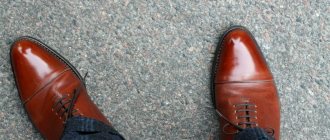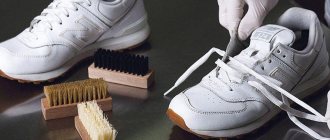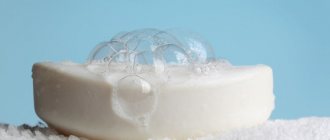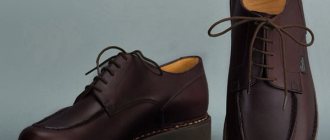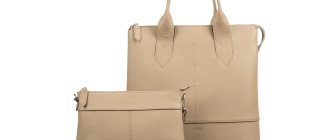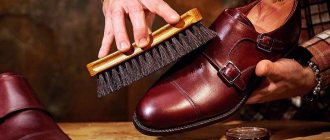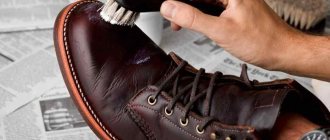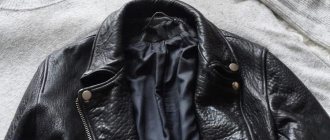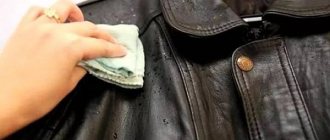How to care for a leather jacket at home
If you have a leather item in your wardrobe and you want it to retain its attractive appearance longer, follow these simple rules.
- Be sure to remove the new jacket from the bag so that the leather is better preserved; it needs access to air.
- Store the item only on hangers, and you need to select them strictly according to the size of your clothing. If you do not intend to wear the product in the near future, protect it from dust and contact with other clothing using a fabric cover. You can buy it in a store or sew it yourself.
- When the surface of the leather becomes dull, this indicates that the product needs cleaning. Don’t put it off, but get to work right away, otherwise street dust and other contaminants will penetrate deeply into the coating and it will be much more difficult to tidy up the jacket.
- When cleaning your leather jacket, don't forget about the lining. The fabric can be treated with alcohol, and if it is very dirty, with a solution of laundry soap.
- When sending things to dry, hang them on hangers, straightening out the folds. The best place for drying is considered to be a balcony; the main thing is to ensure that the product is not exposed to direct sunlight.
- Never dry wet leather items on radiators, otherwise the material will dry out and become deformed.
- To prevent cracks in the leather, treat the jacket with a special softening compound or glycerin.
By following these rules, you can keep your item in good condition for a long time.
What not to do
Many people use the old fashioned way to remove creases and wrinkles from clothes that are ineffective. At best, they do not give the desired result; at worst, they worsen the appearance of the product.
Let it sag
If you need an item urgently, then this is not the best option. It is not suitable for products made of thick, rough leather. A jacket, dress, or raincoat needs to hang on hangers for several days for shallow, fresh creases to disappear.
Smoothing with hot air
It is not recommended to use a hairdryer on folds. A blast of hot air will not smooth them out. It will dry out natural leather, making it rough and tough.
Using hot water
It is not recommended to immerse things made of genuine leather in hot water. With prolonged exposure to hot liquid, they lose elasticity, color, and shape.
Stretching folds
When you stretch the folds of the skin with your hands, the item becomes deformed. The shape is not completely restored, convex areas appear.
Breaking in
A long walk in the rain cannot restore your skin to its former smoothness. Exposure to damp air softens it, but only small creases are smoothed out.
Leather jacket care products
Today in hardware stores you can find a huge number of skin care products for home use. How to understand the rich assortment, what is really needed, and what can you do without? The main means necessary to preserve the material are the following compositions.
Leather polish
These care products help restore shine to dull leather. After applying the polishing compound, the surface will again become smooth and shiny, as on the day of purchase.
But this wonderful product has a significant drawback - its effect leads to rapid wear of the skin, so it can be used rarely, on special occasions.
Before use, you need to make sure that the polish will not damage the material and test it on an inconspicuous area.
Water repellents
There are sprays with different compositions that protect the skin from moisture in damp and rainy weather. And also from dampness if the item is stored in a room with insufficiently dry air.
Products with silicone or acrylic add extra shine to the skin, but formulations with fat or wax are considered the most effective.
They protect against moisture well, but may cause slight discoloration of the skin. Such substances are used once every 2–3 months. There is no need to use them more often.
Conditioners for leather products
These compositions normalize the fat balance of the material, thereby reducing the risk of cracks and increasing the wear resistance of the product.
However, you should not abuse the product or apply the conditioner too often, otherwise this will lead to a change in the structure of the material, and as a result, the appearance of the product. Use it only in cases where the skin is completely rough and has lost its elasticity.
Basic Rules
So, the label has been studied, there are clear ideas about whether or not this type of leather should be subjected to certain types of cleaning, ironing and drying. Next, it’s worth moving on to the basic requirements for storing such a thing.
Outerwear made of genuine leather should be stored in an upright position on soft, wide hangers and in a dry place. If the jacket lies for a long time, even neatly folded, then rough folds will certainly form at the fold, which will be difficult to get rid of. In order to avoid stretching the pockets, it is necessary to remove the contents from them in advance. Items such as keys, phones and iron coins can significantly damage the appearance of your pocket. It is preferable to choose soft and wide shoulders for the same reasons, since some types of leather are strongly subject to stretching and sagging.
Before use, you must treat your leather jacket with a special water-repellent aerosol or lotion. This product forms a protective light and invisible layer on the surface of clothing and protects it from moisture absorption and getting wet. In damp and humid weather, it is necessary to treat the jacket 2-3 times a week if it is worn frequently. In addition to the water-repellent emulsion, it is necessary to use moisturizing creams and aerosols designed to nourish the skin. These nutrients can moisturize the skin and prevent cracks and premature abrasions from appearing on it.
First of all, the collar area, cuffs on the sleeves, pockets and the bottom of the jacket are processed. These places are most often subject to friction, both with the body and surrounding objects. It’s still not worth getting carried away with such nourishing products, since the material can be noticeably over-moistened, and the skin will become much darker in the places where the products were applied. It is worth noting that it is enough to treat a leather jacket with this product once a week. It is necessary to choose care products only those intended for clothing. But there are several deviations from the rules. For example, castor oil perfectly nourishes and gives a glossy appearance to leather products.
Regular cleaning of clothes will help avoid problems with removing old dirty stains. In order to clean a leather product from dirt, you should first use a dry and soft cloth. The area of contamination is wiped and traces are removed. If there is a need to clean with a damp cloth, then you should first check how the skin reacts to moisture. For example, this type of leather, like husky, is very delicate and does not tolerate excess moisture. Laika products are designed for dry and warm weather. When water gets in, dark stains appear on it, which are difficult to get rid of. It is cleaned only with a dry method, and in case of severe contamination, it is sent to dry cleaning. Caring for a leather jacket and using one or another method for this depends on the type of leather.
There are also certain rules for preparing things for long-term storage, namely, when it comes to the season, the jacket must be cleaned of dirt. To do this, first wipe it with a soft, dry cloth. After which, if possible, use a damp cloth to go over the entire surface of the item. To dry, outerwear is hung in a dry and well-ventilated area and always on a trempel. It is hung in the wardrobe already in a special case made of natural material, inside of which you can place a sachet with a pleasant aroma against harmful insects and parasites. It is recommended to use covers for storing clothes to prevent external mechanical damage and exposure to sunlight.
We recommend that you read
How to care for a leather jacket using folk remedies
In order for the leather to last longer and not become cracked, it is necessary to soften it, especially in cases where you use soap or washing powder to clean the surface. These substances perfectly remove dust and dirt, but dry out the material, making it brittle and inelastic.
To soften your skin, you can use the following products that every housewife can find. They must be used after first cleaning the jacket from dust and dirt using a damp sponge or soft cloth. You can apply the compositions when the skin is dry.
Ammonia and glycerin
Treat your leather jacket with a cotton swab soaked in ammonia; this will help remove excess oil from the leather, which you cannot always remove by wiping the material with a sponge.
When the caustic substance evaporates and the surface becomes dry again, apply glycerin to the skin. In order for the product to be evenly distributed throughout the material and absorbed faster, preheat it in a water bath.
Castor oil and egg white emollient
Beat the white of one egg into a strong foam and add 50 ml of castor oil. Mix the composition to obtain a homogeneous mass, and treat the leather jacket with foam rubber soaked in a homemade “softener”.
Soap solution with fish oil and ammonia
Grind ½ bar of laundry soap on a grater and dissolve the shavings in a liter of hot water. When the composition becomes homogeneous, pour in a teaspoon of fish oil and 3 tablespoons of ammonia. Stir the solution again and, after soaking a cotton swab in it, distribute the softening agent evenly over the jacket.
Butter and ammonia
Mix warm water and butter in equal parts, and then dilute with ammonia. The amount of ammonia should be three times less than oil and water.
Bring the mixture to a homogeneous state, stirring constantly, and then apply it to the skin using a cotton swab or disk.
Methods
Grease stains on sleeves and collars are removed with a solution of glycerin soap, and at the final stage of the procedure, wipe the damp surface.
You can also use another method: place a paper napkin on the dirty area, and then gently iron the problem area with an iron.
When exposed to high temperatures, the paper will absorb fat. Dried dirt should be removed with a damp cloth, which should first be soaked in a soap solution, but it is important to remember that there should not be a lot of water on the leather jacket. Acetone or gasoline can effectively remove paint stains, and the specific smell will evaporate as soon as you treat the stained area with a slice of lemon. A napkin treated with an acetic acid solution will help prevent salt stains that form after precipitation. The faded color of the product can also be eliminated. To do this, treat the surface of the skin with lemon juice, after which it will become shiny again. You can get rid of roughness of the material and cracks using a sponge pre-moistened in a glycerin solution
After this, microcracks will become almost invisible. As an alternative to the glycerin composition, we can recommend regular chicken yolk, which should be beaten in advance. Traces of mold on the jacket are removed using gasoline.
How to care for a white leather jacket
On white things, dust and dirt are more noticeable, and as for light skin, even the smallest scratches on the surface immediately catch the eye. Therefore, it is especially important to protect such things from damage. How to soften a white leather jacket? Caring for light-colored leather products involves using one of these products.
Turpentine and cow's milk
Add a small amount of turpentine to the heated milk, stir the composition, and, taking a cotton swab, spread the product over the surface.
In this way, you will not only soften the leather, but also cleanse the jacket of grease and street dirt, and also refresh the color.
Stationery chalk or potato starch
Dilute any of these products with water to form a paste mixture. Distribute it over the surface, leave for half an hour, and then rinse off the composition with water. Dry the skin with a soft cloth and apply glycerin.
This method of treatment will remove impurities, whiten and soften the skin.
Body milk
It is very uneconomical to use this product in its pure form, so it is diluted with water in a 1:1 ratio and stirred until a homogeneous mass is obtained. The product is applied in a thin layer to white skin and left for some time so that the composition is well absorbed into the material.
Leather or substitute
Genuine leather looks practically no different from leatherette
Often, when purchasing an item in a store, we ask the question “Is it made of leather or faux leather?”, because each of us wants to buy a good, high-quality product, and at the same time, it would be nice to pay less. Here enterprising sellers enter the scene, offering customers artificial leather, positioning it as genuine leather. Faux leather is pressed leather that imitates a whole cloth; the difference is that genuine leather is a whole skin taken from an animal and carefully processed. Leather is much stronger and more reliable than leatherette, it serves its owners much longer. When leatherette is at risk of bursting - after a few weeks or months, it depends on the quality. It is possible that high-quality leatherette can last for several years, but most often the products begin to deteriorate much earlier. As you know, a miser pays twice, so it’s better to save a little money and buy a quality item. You can distinguish leather from a substitute by the label on the clothing, the smell and the cuts, which will be hidden in a high-quality leather product. If you press your hands to the product, genuine leather will absorb the heat of your palms, while leatherette will remain cold.
How to properly clean and dry a leather jacket
It is not recommended to machine wash leather goods, although many owners of such items neglect this prohibition. However, it is better to clean your jacket by hand. To do this you need to do the following:
- Prepare a solution of laundry soap and use a foam sponge or soft cloth to remove dirt from the surface.
- Treat the lining with a cotton swab dipped in alcohol. If the fabric is too dirty, wash it in warm water using laundry soap or hand washing powder.
- Then the jacket should be allowed to drain (if you washed the lining), and in case of superficial cleaning, it is enough to wipe it with a dry towel.
- Hang the jacket on hangers, straighten out folds and creases and leave to dry in the fresh air or in a well-ventilated room.
- After the product is completely dry, treat it with a leather softener, special or improvised.
By following the recommendations for caring for leather products, you can wear your favorite jacket for a long time and not think about buying a new one.
Removing unpleasant odor
The skin has the ability to absorb different odors, which, when mixed, form a persistent unpleasant odor. To remove it, you need:
- Ventilate by taking it out into the fresh air.
- Remove dirt using one of the following methods.
- Fill the bathtub with hot water, add vinegar or ammonia. Hang a jacket over the bathtub to absorb the steam.
- Wrap the jacket in newspapers for a few days.
- Sprinkle with coffee (only dark colored jacket!).
Application of air conditioner
In addition to storing leather products in a climate-controlled environment with a relative humidity of 40-50%, it also requires regular care and proper cleaning.
Use conditioner. This product will soften the material, giving it the necessary moisture.
Leather conditioners are designed to help protect the fabric from drying out. Simply apply the product to the surface of the product, rubbing gently. The conditioner seeps into the pores of the skin, moisturizes and softens it from the inside.
Tips for suede
Suede clothing requires special and delicate care. The peculiarity of caring for it is proper dry cleaning and regular treatment with special products. To care for a suede leather jacket you will need:
- 1Universal impregnation for this type of leather, which will protect it from moisture and dirt. This product covers the fleecy surface and does not allow dust and other contaminants to penetrate deeply into the material. Thanks to these products, cleaning is quick and easy.
- 2Special eraser and brush. Remains of dust and dirt are removed from the skin only after it has completely dried. Using a brush with soft bristles, dirt is removed from the surface; it is worth cleaning in one direction, and not rubbing in one place. Then use an eraser to go over the entire surface to be cleaned. Using a springy sponge or brush, fluff the lint on the clothes and set it in one direction.
To remove greasy stains and greasy, worn-out areas on suede, you can use:
- 1Ammonia, take about 10 drops of alcohol per 250 ml of water. Use this solution to wipe the stain. After treatment, wipe the fabric with a clean damp cloth and dry the item. Drying must be done in a dry room, away from radiators.
- 2Vinegar can also cleanse the skin of greasy stains. Vinegar is diluted with water in the following proportion: add 15 ml of vinegar to 250 ml of water. Dip a cotton pad into this solution and wipe the stained areas with it. Residues are removed with a clean damp cloth.
- 3Dissolve hydrogen peroxide in water and wipe the jacket with this solution. Peroxide is added to 0.5 cups of water in the amount of 1 tsp.
If creases appear on a leather jacket, they can be removed with steam. To do this, fill the bathtub with hot water and hang the jacket over the water for 10–15 minutes. The vertical steam mode on the iron is also perfect; the main thing is to correctly calculate the distance and temperature on the device.
It is important to remember that before carrying out any cleaning measures on leather clothing, you should initially test them on the inside of the product, hidden from view.

